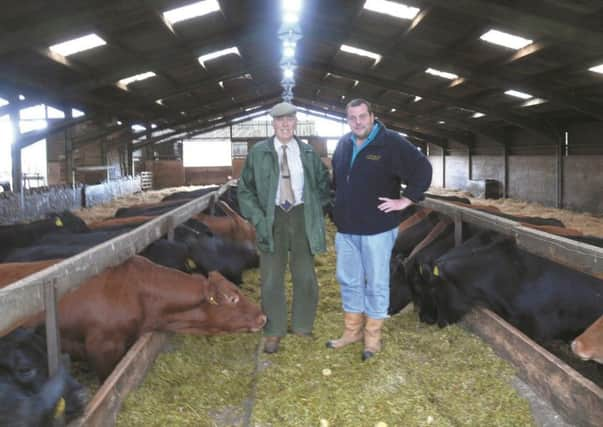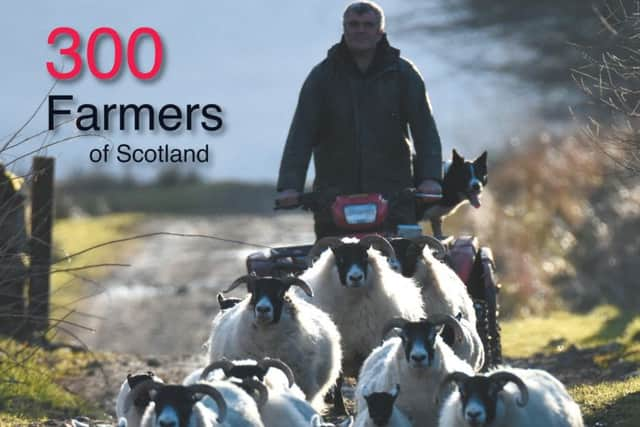Braes of Burnshot feature in 300 Farmers of Scotland


And it’s that seam Eilidh MacPherson tapped into to create her latest book, 300 Farmers of Scotland.
The editor of a bi-monthly magazine focusing on the farming industry, Eilidh used her contacts to get started on the book.
Advertisement
Hide AdAdvertisement
Hide AdShe personally knew around 80 farmers who are featured and word of mouth helped her discover even more who had stories to tell.


The compilation provides a glimpse of the innovation used by today’s farmers to ensure they not only survive but thrive.
Eilidh said: “I found it really interesting finding out what the farmers are doing differently these days – it was very enjoyable.
“The truth is I’ve only just scratched the surface as there are around 16,000 farmers in Scotland.
Advertisement
Hide AdAdvertisement
Hide Ad“However, I’ve already started on the second instalment and I’m hoping that will be ready in time for Christmas this year.”


300 Farmers of Scotland was released in December and won rave reviews.
And the Braes family of Burnshot Farm in Blackness are among those who feature within its 280 glossy pages.
Billed under Lothians within the book, it also states that the region covers 262,400 hectares with a farmland area of 132,143 hectares.
Advertisement
Hide AdAdvertisement
Hide AdThe area boasts 1504 farms and holdings with 505 farms of 50 hectares or more including 140 lowland beef and sheep, 15 dairy farms, 76 specialist sheep, 62 specialist beef, 252 cereal, 39 specialist poultry and 222 mixed.
Understandably, therefore, it was no mean feat for Eilidh to select the pick of the crop for 300 Farmers of Scotland.
However, having already visited Burnshot Farm on several occasions, it was an easy choice for Eilidh.
She said: “My first visit to Burnshot was in 1994 while procuring cattle for a marketing group.
Advertisement
Hide AdAdvertisement
Hide Ad“The late Bobby Braes showed me round the cattle courts – the buildings were full to the gunnels with black cattle at varying stages of finish.”
Little surprise really, as Burnshot is renowned for its quality finished Aberdeen Angus cattle.
This time around, Eilidh met up with Bobby’s son, Robin Braes, and his uncle, William.
Together, the duo purchase Angus bullocks aged over 12 months from markets all over central Scotland.
William explained the process in the book.
Advertisement
Hide AdAdvertisement
Hide AdHe said: “We buy in from trusted sources; some of the farms we have dealt with for generations.
“If the cattle are right and finish well, we will go back and attempt to buy more – but they are getting harder and harder to find.”
There is a strict protocol William and Robin adhere to in a bid to ensure their cattle is the best in the land.
Firstly, they check the ear tag and passport before the cattle go into sheds or out to grass.
Advertisement
Hide AdAdvertisement
Hide AdEverything is then logged onto the computer and passports stored, according to which field or pen each beast has been allocated.
Robin explained: “We check the Angus sire name and number, which is sometimes on the rear of the passport, as we have to know for Scotbeef.
“We then find out the dam breed so we know if the individual is 50 per cent, 75 per cent or pure Angus as it makes a difference to how much premium you get.”
Around 95 per cent of the Braes’ finished cattle go to Scotbeef.
Advertisement
Hide AdAdvertisement
Hide Ad“We also have private butchers who like certain weights of cattle,” said Robin.
The Braes have been dealing with one butcher’s shop since 1928 and quite a few also visit Burnshot as they like to see what the cattle look like on the hoof.
“That is the benefit of dealing direct with the butchers – it makes them comfortable to see what they are buying,” added Robin.
The Braes aim to fatten as many cattle off grass as possible from the fields near their farm.
Advertisement
Hide AdAdvertisement
Hide AdThey also have a unique way of ensuring against ringworm – male holly, minus the berries!
William explained: “An old guy told us this years ago and we thought it would be an old wives’ tale.
“But the wee bit of ringworm that was present cleared up and we haven’t been bothered by it since!”
Top tip – and there are plenty of more ripe for reading from 299 other farms in Eilidh MacPherson’s 300 Farmers of Scotland, which is available from local outlets now, priced £25.
Eilidh speaks from experience
Advertisement
Hide AdAdvertisement
Hide AdEilidh MacPherson combines hill sheep farming at Marbrack – between Ayr and Castle Douglas – with her husband Richard Nixon.
Together they farm 2500 acres carrying 1200 Blackface sheep.
Eilidh is also editor of a now bi-monthly publication, Farming Country magazine, which was known as farmingscotland.com when it was free.
Her last book From Thistle to Fern, which was published a decade ago, featured Scots who had emigrated to New Zealand and set up the high country sheep stations.
Advertisement
Hide AdAdvertisement
Hide AdEilidh is a hill sheep and beef farmer’s daughter from the Isle of Skye and headed off overseas once she graduated in agriculture from Edinburgh.
She spent six seasons as a professional sheep shearer, employing Kiwis on Skye, then headed to the Antipodes for the winter.
She managed a lamb group, worked for Scotch Quality Beef and Lamb and then as an independent livestock buyer.
While in New Zealand, Eilidh wrote full time for the New Zealand Farmer for a couple of years covering Southland and South Otago.
Advertisement
Hide AdAdvertisement
Hide AdShe also freelanced for a number of other titles including High Country Herald, Shearing Magazine, Southland Times and the Otago Southland Farmer.
Farmingscotland.com magazine was launched in September 2003 on her return from overseas – a free monthly title.
It changed its name to Farming Country in 2012 so it could be sold in newsagents and shops across Scotland, Northern England and Northern Ireland.
300 Farmers of Scotland is available now from local outlets, priced £25. Follow Eilidh on Facebook at farmingscotland.com or Twitter @farmingscotland.